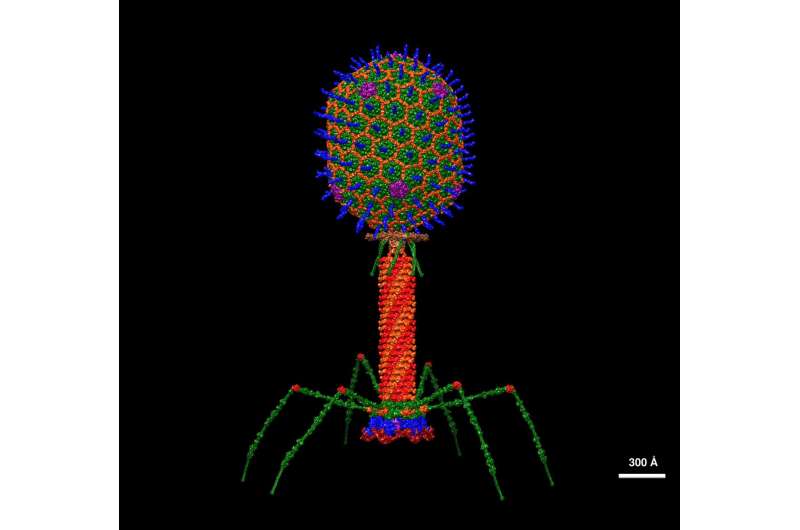
Atomic structural model of bacteriophage T4 in UCSF Chimera software using pdbs of the individual proteins. Credit: Dr. Victor Padilla-Sanchez, PhD, CC BY-SA 4.0
This week, we reported on LIGO upgrades, parasitic fungi and a new analysis of Curiosity rover data. Also, did you know that viruses also attack bacteria? But at that scale, it’s a lot less like catching a cold and a lot more like Harry Dean Stanton encountering the xenomorph in “Alien.”
Quanta squeezed
The quantum limit is not so limiting for the Laser Interferometer Gravitational-Wave Observatory anymore, as physicists are now exploiting a quantum effect called “squeezing” that allows them to measure gravitational space-time waves across the entire range of gravitational frequencies the observatory detects. As a result, they expect to observe 60% more space-time-undulating mergers of black holes and neutron stars.
So: Squeezing. This refers to the fact that light can be squeezed to be more precise in one trait, such as its frequency, and simultaneously less precise in another trait, such as power. This is another expression of the Heisenberg uncertainty principle, which states that you cannot know two traits simultaneously. The upgraded LIGO technology has been in operation since May 2023, when the observatory resumed observations.
Mushrooms preparing
“The Last of Us,” a venerable old PlayStation action game and now a pretty great HBO series, posits the collapse of society caused by a parasitic fungus that turns living organisms into mushroom zombies and is now also the cultural touchpoint referenced in every article about fungi, which I’m doing right now. My question is this: Why aren’t the writers trying to wring a little more tension out of the fear of airborne fungal spores?
Because that would clearly be an enormous threat, especially inside the cavernous ruins of warehouses and malls where the walls are absolutely wainscoted with masses of fungal matter. Consider this: Mycologists at the University of Copenhagen have discovered that bonnet mushrooms have evolved the ability to invade the roots of living plants.
However, they also provide evidence that these Mycena fungi may be in the process of developing into mutualists, symbiotic organisms that provide a beneficial advantage to the trees they invade.
Rivers diminished
Today, Mars is a terrible place completely inhospitable and openly antagonistic to life. The atmospheric pressure is close to a vacuum. The temperatures are frigid. There’s no magnetic field, which means zero shielding against solar and cosmic radiation. I give Elon Musk four weeks on the planet before he rockets back toward Earth, leaving behind all of the volunteers and SpaceX employees who came with him. He’ll post a cry-laugh emoji and something like “they knew what they were getting into.”
But Mars might once have been homier. New analysis of data from the Curiosity rover reveals that Mars was likely a planet of rivers. Using numerical models, researchers simulated erosion on Mars over thousands of years and determined that common geological formations are most likely the remnants of riverbeds. Follow me, here: Everyone knows where rivers meet oceans, you have riparian zones.
Where there are riparian zones, you have bears catching fish. Could bears have existed on Mars? We’re not weighing in one way or the other, but Benjamin Cardenas, assistant professor of geosciences at Penn State, says, “Our research indicates that Mars could have had far more rivers than previously believed, which certainly paints a more optimistic view of ancient life on Mars.”
Phages friendly
Bacteriophages are viruses that attack and kill bacteria. A research collaborative led by Monash University’s Jeremy J. Barr recently explored the impact of bacteriophages on mammalian cell immune responses, applying bacteriophage T4 to mammalian cells in vitro.
The relatively large T4 looks like a hybrid of a lunar lander and a syringe, using its long tail fibers to land on E. coli cells and puncturing the bacteria’s outer membrane with its tail tube. Once the membrane is degraded, T4 injects the genetic cargo from its own head into the bacteria, which multiplies nearly instantly, while Elton John belts out “It’s the circle of liiiiiii-iiiiiiife!”
The researchers found that when exposed to T4, mammalian cells do not activate DNA-mediated inflammatory pathways, but instead trigger signaling pathway events that promote cellular growth and survival. They say that this insight into the potentially beneficial interactions between phages and mammalian cells could contribute to the use of phage therapy for antibiotic-resistant infections.
© 2023 Science X Network
Citation:
Saturday Citations: Mars limnology, phage immunology, quantum technology. Plus: The mushrooms are coming (2023, October 28)
retrieved 28 October 2023
from https://phys.org/news/2023-10-saturday-citations-mars-limnology-phage.html
This document is subject to copyright. Apart from any fair dealing for the purpose of private study or research, no
part may be reproduced without the written permission. The content is provided for information purposes only.
>>> Read full article>>>
Copyright for syndicated content belongs to the linked Source : Phys.org – https://phys.org/news/2023-10-saturday-citations-mars-limnology-phage.html































